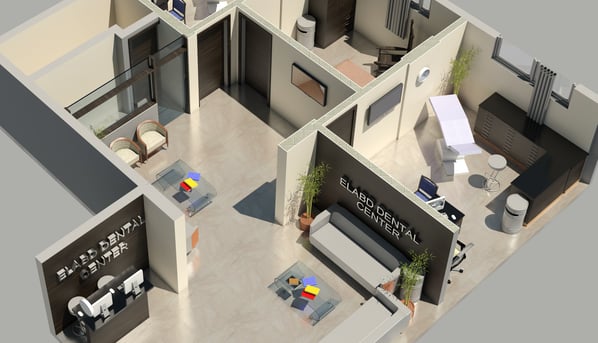Dental Clinic Layouts
Creating an effective layout for a dental clinic involves a meticulous balance between operational efficiency and an aesthetically pleasing environment. The layout not only needs to support the smooth flow of patients and staff but also needs to evoke a sense of calm and trust among patients. This blog explores key considerations for designing dental clinic layouts that harmonize functionality with aesthetics, ensuring a welcoming and efficient space.
Core Considerations in Dental Clinic Design
Balancing Functionality and Aesthetics
An optimal layout directs patients seamlessly from their point of entry, through their appointment, to their departure without backtracking or confusion. A clear path minimizes stress for patients and interruptions for staff, enhancing the overall clinic experience.
Privacy and Comfort
Treatment areas should be designed to maximize patient privacy, using partitions or frosted glass where appropriate. The waiting area should be positioned away from treatment rooms to reduce anxiety among waiting patients caused by hearing dental procedures.
Accessibility
Balancing Functionality with Aesthetics
Natural Light and Views
Incorporating natural light and outdoor views can significantly enhance the aesthetic appeal of a clinic while also reducing patient anxiety. Strategic placement of windows and skylights can illuminate treatment and waiting areas, creating a more inviting space.
Color Scheme and Materials
The color palette and materials used throughout the clinic can impact both aesthetics and functionality. Soft, calming colors promote relaxation, while durable, easy-to-clean surfaces ensure hygiene and longevity. The choice of materials should reflect the clinic's identity and contribute to a cohesive look.
Flexible Treatment Areas
Modern dental clinics are moving towards more versatile treatment areas that can adapt to various types of appointments. Modular furniture and equipment can be reconfigured as needed, allowing the clinic to evolve with changing technologies and patient needs.
Integrating Technology
The thoughtful incorporation of technology can enhance both functionality and aesthetics. Digital check-in kiosks can streamline the arrival process, while hidden wiring and integrated equipment keep treatment areas uncluttered and visually appealing.
Waiting Area as a Focal Point


The waiting area sets the tone for the patient's experience. It should be comfortable, inviting, and reflective of the clinic's brand. Incorporating elements such as art, comfortable seating, and amenities like Wi-Fi and refreshments can make waiting times more pleasant.
Innovative Layout Strategies
Compliance with accessibility standards is crucial, ensuring that patients with mobility challenges can navigate the clinic easily. This includes wide corridors, accessible restrooms, and treatment rooms that accommodate wheelchairs.
Music Selection
Zoning
Dividing the clinic into distinct zones for reception, waiting, treatment, and staff areas can enhance operational efficiency while allowing for targeted aesthetic treatments in each zone to optimize their intended function.
Open Plan vs. Private Rooms
An open-plan layout can facilitate communication and supervision in pediatric and orthodontic practices. However, private treatment rooms are preferable for general and cosmetic dentistry, where patient privacy and comfort are paramount.
Patient Flow
Staff Efficiency
The layout should also consider staff workflow, including the placement of sterilization rooms, equipment storage, and staff break areas. Efficient staff workflows contribute to a smoother patient experience and a more cohesive working environment.
Designing a dental clinic layout that balances functionality with aesthetics requires careful consideration of patient flow, privacy, and comfort, alongside the integration of natural elements, technology, and flexible spaces. By focusing on these key aspects, dental professionals can create a clinic that not only meets operational needs but also provides a welcoming and calming environment for patients, ultimately contributing to a positive perception of the dental experience.
Conclusion
